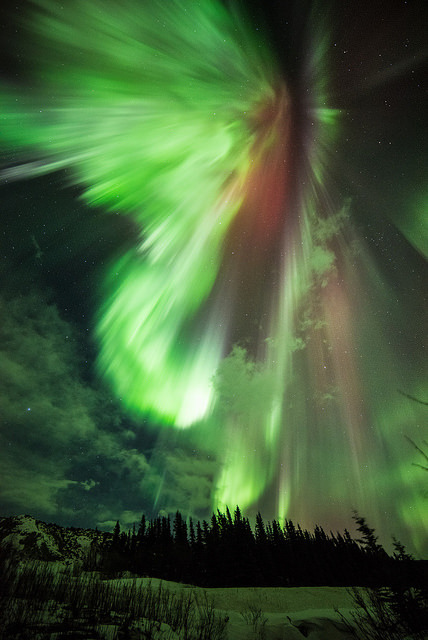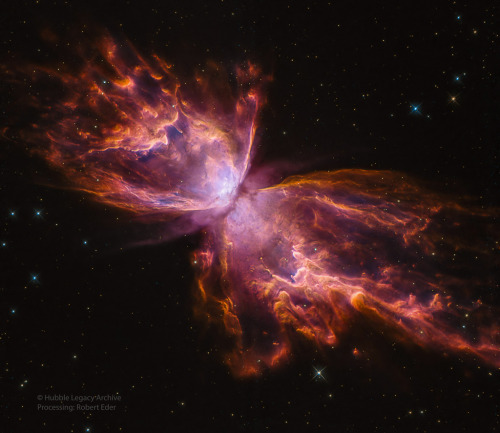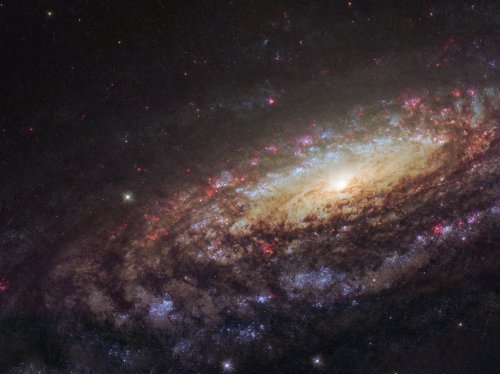Happy 4th Of July… From Space!
Happy 4th of July… From Space!
In Hollywood blockbusters, explosions and eruptions are often among the stars of the show. In space, explosions, eruptions and twinkling of actual stars are a focus for scientists who hope to better understand their births, lives, deaths and how they interact with their surroundings. Spend some of your Fourth of July taking a look at these celestial phenomenon:

Credit: NASA/Chandra X-ray Observatory
An Astral Exhibition
This object became a sensation in the astronomical community when a team of researchers pointed at it with our Chandra X-ray Observatory telescope in 1901, noting that it suddenly appeared as one of the brightest stars in the sky for a few days, before gradually fading away in brightness. Today, astronomers cite it as an example of a “classical nova,” an outburst produced by a thermonuclear explosion on the surface of a white dwarf star, the dense remnant of a Sun-like star.

Credit: NASA/Hubble Space Telescope
A Twinkling Tapestry
The brilliant tapestry of young stars flaring to life resemble a glittering fireworks display. The sparkling centerpiece is a giant cluster of about 3,000 stars called Westerlund 2, named for Swedish astronomer Bengt Westerlund who discovered the grouping in the 1960s. The cluster resides in a raucous stellar breeding ground located 20,000 light-years away from Earth in the constellation Carina.

Credit: NASA/THEMIS/Sebastian Saarloos
An Illuminating Aurora
Sometimes during solar magnetic events, solar explosions hurl clouds of magnetized particles into space. Traveling more than a million miles per hour, these coronal mass ejections, or CMEs, made up of hot material called plasma take up to three days to reach Earth. Spacecraft and satellites in the path of CMEs can experience glitches as these plasma clouds pass by. In near-Earth space, magnetic reconnection incites explosions of energy driving charged solar particles to collide with atoms in Earth’s upper atmosphere. We see these collisions near Earth’s polar regions as the aurora. Three spacecraft from our Time History of Events and Macroscale Interactions during Substorms (THEMIS) mission, observed these outbursts known as substorms.

Credit: NASA/Hubble Space Telescope//ESA/STScI
A Shining Supermassive Merger
Every galaxy has a black hole at its center. Usually they are quiet, without gas accretions, like the one in our Milky Way. But if a star creeps too close to the black hole, the gravitational tides can rip away the star’s gaseous matter. Like water spinning around a drain, the gas swirls into a disk around the black hole at such speeds that it heats to millions of degrees. As an inner ring of gas spins into the black hole, gas particles shoot outward from the black hole’s polar regions. Like bullets shot from a rifle, they zoom through the jets at velocities close to the speed of light. Astronomers using our Hubble Space Telescope observed correlations between supermassive black holes and an event similar to tidal disruption, pictured above in the Centaurus A galaxy.

Credit: NASA/Hubble Space Telescope/ESA
A Stellar Explosion
Supernovae can occur one of two ways. The first occurs when a white dwarf—the remains of a dead star—passes so close to a living star that its matter leaks into the white dwarf. This causes a catastrophic explosion. However most people understand supernovae as the death of a massive star. When the star runs out of fuel toward the end of its life, the gravity at its heart sucks the surrounding mass into its center. At the turn of the 19th century, the binary star system Eta Carinae was faint and undistinguished. Our Hubble Telescope captured this image of Eta Carinae, binary star system. The larger of the two stars in the Eta Carinae system is a huge and unstable star that is nearing the end of its life, and the event that the 19th century astronomers observed was a stellar near-death experience. Scientists call these outbursts supernova impostor events, because they appear similar to supernovae but stop just short of destroying their star.

Credit: NASA/GSFC/SDO
An Eye-Catching Eruption
Extremely energetic objects permeate the universe. But close to home, the Sun produces its own dazzling lightshow, producing the largest explosions in our solar system and driving powerful solar storms.. When solar activity contorts and realigns the Sun’s magnetic fields, vast amounts of energy can be driven into space. This phenomenon can create a sudden flash of light—a solar flare.The above picture features a filament eruption on the Sun, accompanied by solar flares captured by our Solar Dynamics Observatory.
Make sure to follow us on Tumblr for your regular dose of space: http://nasa.tumblr.com
More Posts from Nasa and Others

DYK the bright clusters and nebulae of planet Earth's night sky are often named for flowers or insects?
Though its wingspan covers over 3 light-years, NGC 6302: The Butterfly Nebula is no exception! With an estimated surface temperature of about 250,000 degrees C, the dying central star of this particular planetary nebula has become exceptionally hot, shining brightly in ultraviolet light but hidden from direct view by a dense torus of dust. This sharp close-up was recorded by the Hubble Space Telescope in 2009. The Hubble image data is reprocessed here, showing off the remarkable details of the complex planetary nebula.
Image Credit: NASA, ESA, Hubble, HLA; Reprocessing & Copyright: Robert Eder
Make sure to follow us on Tumblr for your regular dose of space: http://nasa.tumblr.com.
Studying Sediments in Space
An International Space Station investigation called BCAT-CS studies dynamic forces between sediment particles that cluster together.

For the study, scientists sent mixtures of quartz and clay particles to the space station and subjected them to various levels of simulated gravity.

Conducting the experiment in microgravity makes it possible to separate out different forces that act on sediments and look at the function of each.

Sediment systems of quartz and clay occur many places on Earth, including rivers, lakes, and oceans, and affect many activities, from deep-sea hydrocarbon drilling to carbon sequestration.

Understanding how sediments behave has a range of applications on Earth, including predicting and mitigating erosion, improving water treatment, modeling the carbon cycle, sequestering contaminants and more accurately finding deep sea oil reservoirs.

It also may provide insight for future studies of the geology of new and unexplored planets.

Follow @ISS_RESEARCH to learn more.
Make sure to follow us on Tumblr for your regular dose of space: http://nasa.tumblr.com.
Go Behind the Scenes of Science in Space

Gravity rules everything on Earth, from how our bodies develop to what our research can reveal, but what happens when we go 250 miles up to the International Space Station?

Get ready to go behind the scenes of what it takes to get science to space, and meet the people who make it happen.

Introducing Season 4 of NASA Explorers: Microgravity. Floating isn’t just fun. Microgravity could open the door to discovery.
You’ve seen things floating in space, but why does that happen and how does it affect science being conducted aboard the International Space Station?
Microgravity makes the International Space Station the perfect place to perform research that is changing the lives of people on Earth, and preparing us to go deeper into space. This season on our series NASA Explorers, we are following science into low-Earth orbit and seeing what it takes to do research aboard the space station.
Follow NASA Explorers on Facebook to catch new episodes of season 4 every Wednesday!
Did the training ever get so hard that you would regret getting into this?
No because the end goal is space!

Say hello to spiral galaxy NGC 7331👋
Happy National Twin Day!
The majestic spiral galaxy NGC 7331 is almost like a long lost twin to our very own Milky Way. In this close-up, the galaxy’s magnificent spiral arms feature dark, obscuring dust lanes, bright bluish clusters of massive young stars and the telltale reddish glow of active star-forming regions. The yellowish central region harbors populations of older, cooler stars. Like in the Milky Way, a supermassive black hole lies at the galaxy’s core.
Our Hubble Space Telescope took this image while observing a supernova explosion — the fiery death of a massive star — within NGC 7331. Astronomers noted that the supernova, called SN 2014C, experienced a dramatic, hasty transformation that involved a significant upsurge in hydrogen content. This observation provided a rare chance to gain insight into the final stages of massive stars.
NGC 7331 was discovered in 1784 by famed astronomer William Herschel, who discovered the planet Uranus. It was originally classified as a nebula, which is an interstellar cloud of gas and dust, because no one knew that other galaxies existed until the 20th century. It turns out that NGC 7331 and the Milky Way are among billions and billions of galaxies in the universe!
Make sure to follow us on Tumblr for your regular dose of space: http://nasa.tumblr.com.

"A classic that I never get tired of: the orange solar panel in front of the blue–white background and the curvature of Earth" wrote astronaut Thomas Pesquet (@thom_astro) of the European Space Agency from aboard the International Space Station.
The space station serves as the world's leading laboratory for conducting cutting-edge microgravity research, and is the primary platform for technology development and testing in space to enable human and robotic exploration of destinations beyond low-Earth orbit, including Mars.
Credit: NASA/ESA

Peering deep into the core of the Crab Nebula, this close-up image reveals the beating heart of one of the most historic and intensively studied remnants of a supernova, an exploding star. The inner region sends out clock-like pulses of radiation and tsunamis of charged particles embedded in magnetic fields.
The neutron star at the very center of the Crab Nebula has about the same mass as the sun but compressed into an incredibly dense sphere that is only a few miles across. Spinning 30 times a second, the neutron star shoots out detectable beams of energy that make it look like it's pulsating.
The Hubble Space Telescope snapshot is centered on the region around the neutron star (the rightmost of the two bright stars near the center of this image) and the expanding, tattered, filamentary debris surrounding it. Hubble's sharp view captures the intricate details of glowing gas, shown in red, that forms a swirling medley of cavities and filaments. Inside this shell is a ghostly blue glow that is radiation given off by electrons spiraling at nearly the speed of light in the powerful magnetic field around the crushed stellar core.
Read more about this image HERE.
Make sure to follow us on Tumblr for your regular dose of space: http://nasa.tumblr.com
What’s Up in December 2020 – Skywatching Tips from NASA!
Catch the Geminids meteor shower as the peak coincides with darker skies during a new Moon. Plus, Jupiter and Saturn appear closer than in decades, and the winter solstice arrives. Check this out for when and where to observe! Make sure to follow us on Tumblr for your regular dose of space: http://nasa.tumblr.com.
Are we able to take a picture of it
Yup and I hope you share your photos with us on the NASA Eclipse Flicker page! https://www.flickr.com/groups/nasa-eclipse2017/ You can find out about how to safely take photos of the eclipse at https://www.nasa.gov/feature/goddard/2017/five-tips-from-nasa-for-photographing-the-total-solar-eclipse-on-aug-21 Good luck!
The Sun Just Released the Most Powerful Flare of this Solar Cycle
The Sun released two significant solar flares on Sept. 6, including one that clocked in as the most powerful flare of the current solar cycle.
The solar cycle is the approximately 11-year-cycle during which the Sun’s activity waxes and wanes. The current solar cycle began in December 2008 and is now decreasing in intensity and heading toward solar minimum, expected in 2019-2020. Solar minimum is a phase when solar eruptions are increasingly rare, but history has shown that they can nonetheless be intense.

Footage of the Sept. 6 X2.2 and X9.3 solar flares captured by the Solar Dynamics Observatory in extreme ultraviolet light (131 angstrom wavelength)
Our Solar Dynamics Observatory satellite, which watches the Sun constantly, captured images of both X-class flares on Sept. 6.
Solar flares are classified according to their strength. X-class denotes the most intense flares, followed by M-class, while the smallest flares are labeled as A-class (near background levels) with two more levels in between. Similar to the Richter scale for earthquakes, each of the five levels of letters represents a 10-fold increase in energy output.
The first flare peaked at 5:10 a.m. EDT, while the second, larger flare, peaked at 8:02 a.m. EDT.

Footage of the Sept. 6 X2.2 and X9.3 solar flares captured by the Solar Dynamics Observatory in extreme ultraviolet light (171 angstrom wavelength) with Earth for scale
Solar flares are powerful bursts of radiation. Harmful radiation from a flare cannot pass through Earth's atmosphere to physically affect humans on the ground, however — when intense enough — they can disturb Earth’s atmosphere in the layer where GPS and communications signals travel.
Both Sept. 6 flares erupted from an active region labeled AR 2673. This area also produced a mid-level solar flare on Sept. 4, 2017. This flare peaked at 4:33 p.m. EDT, and was about a tenth the strength of X-class flares like those measured on Sept. 6.

Footage of the Sept. 4 M5.5 solar flare captured by the Solar Dynamics Observatory in extreme ultraviolet light (131 angstrom wavelength)
This active region continues to produce significant solar flares. There were two flares on the morning of Sept. 7 as well.
For the latest updates and to see how these events may affect Earth, please visit NOAA’s Space Weather Prediction Center at http://spaceweather.gov, the U.S. government’s official source for space weather forecasts, alerts, watches and warnings.
Follow @NASASun on Twitter and NASA Sun Science on Facebook to keep up with all the latest in space weather research.
Make sure to follow us on Tumblr for your regular dose of space: http://nasa.tumblr.com.
-
 thenerdyrehelps liked this · 4 months ago
thenerdyrehelps liked this · 4 months ago -
 012nion liked this · 1 year ago
012nion liked this · 1 year ago -
 polyvinylfilms reblogged this · 1 year ago
polyvinylfilms reblogged this · 1 year ago -
 bigpoppadean liked this · 2 years ago
bigpoppadean liked this · 2 years ago -
 marklittle liked this · 2 years ago
marklittle liked this · 2 years ago -
 iniverse reblogged this · 3 years ago
iniverse reblogged this · 3 years ago -
 lover-of-procrastination liked this · 3 years ago
lover-of-procrastination liked this · 3 years ago -
 thanatophobia-thoughts reblogged this · 3 years ago
thanatophobia-thoughts reblogged this · 3 years ago -
 fireyhotsupertalia reblogged this · 3 years ago
fireyhotsupertalia reblogged this · 3 years ago -
 keepxsolxinxsolxinvictus reblogged this · 3 years ago
keepxsolxinxsolxinvictus reblogged this · 3 years ago -
 kirbnation reblogged this · 3 years ago
kirbnation reblogged this · 3 years ago -
 kirbnation liked this · 3 years ago
kirbnation liked this · 3 years ago -
 keepxsolxinxsolxinvictus liked this · 3 years ago
keepxsolxinxsolxinvictus liked this · 3 years ago -
 that-galo2 liked this · 3 years ago
that-galo2 liked this · 3 years ago -
 harrycal liked this · 3 years ago
harrycal liked this · 3 years ago
Explore the universe and discover our home planet with the official NASA Tumblr account
1K posts